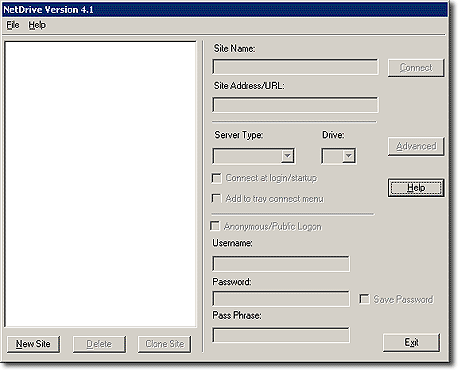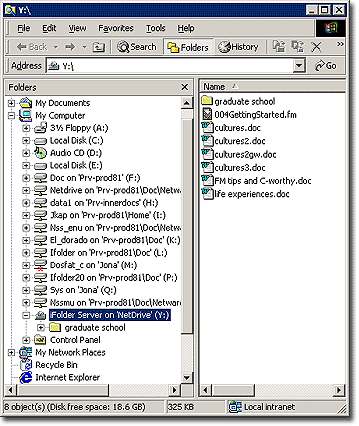2.3 Mapping a Drive
Before mapping a drive, you must meet these prerequisites:
- Install NetDrive on your Windows workstation. (For installation instructions, see Section 2.2, Installing NetDrive.)
- (iFolder server only) Your administrator must enable your username for iFolder services.
- Activate your Internet connection; you do not need a Web browser.
To map a drive to your NetWare 6.x server or to your iFolder server:
-
Contact your network administrator or iFolder administrator to get the following information:
- The server address (the DNS name or IP address of your server)
- The protocol your server is using: iFolder, FTP, WebDAV (HTTP), or WebDAV plus SSL (HTTPS)
- The login method your server requires (anonymous/public login or username/password/encryption passphrase)
-
Open NetDrive using one of these methods:
- Double-click the NetDrive icon in your system tray.
- Click the Start menu > Programs > NetDrive, then click the NetDrive icon.
When you open NetDrive, the NetDrive main window appears, as shown in the following example:
Figure 2-1 NetDrive Main Window

-
Create a NetDrive site that you will use to map this server.
NetDrive uses sites to visually organize the drives that you map with the NetDrive software. A NetDrive site represents a location on the target server that contains a collection of your directories and files. (In this case, the word site does not refer to a Web site.)
-
Click New Site.
-
Type the name of your site into the New Site dialog box.
A site name is simply a way for you to make your mapped drives unique and personal. There are no naming conventions that you must follow here.
-
Specify the server address that you want to connect to.
A server address can be a DNS name or an IP address that serves as the URL of the server.
- (iFolder only) Use only the servername,
such as
nif1.your-domain-name.com
- (FTP only) Use the full URL of the server address,
such as
ftp://svr1.your-domain-name.com
- (WebDAV only) Use the full URL of the server address,
such as
http://192.168.1.1
- (WebDAV + SSL only) Use the full URL of
the server address, such as
https://svr1.your-domain-name.com
If you are connecting to Novell NetStorage, use the following text-based Web interface URL:
https://svr1.your-domain-name.com:portnumber/oneNet/NetStorage
IMPORTANT:This URL is case sensitive.
In each example above, replace nif1.your-domain-name.com, svr1.your-domain-name.com, or 192.168.1.1 with your actual server's DNS name or IP address. Replace portnumber with the actual assigned port number such as 51443.
A DNS name is a unique name that is given to a Web server in addition to the server's IP address. The advantage of using a DNS name is that it is easier to remember and it does not change often, unlike IP addresses. For example, http://www.novell.com is a DNS name.
- (iFolder only) Use only the servername,
such as
-
Click Finish.
When the drive is mapped, a server icon followed by the name of your site appears in the left pane of the NetDrive main windows.
IMPORTANT:After a site is created, the interface will select some default properties for you. Do not assume that these properties will automatically work with the server address that you've entered.
-
-
Select the Internet protocol that the server is running from the Server Type drop-down list. Use the protocol that you got from your administrator in Step 1.
The following table shows what Windows operating systems each Internet protocol supports:
-
Select a drive letter from the Drive drop-down box.
-
Check the Connect at Login/Startup check box if you want to connect to the server when you reboot your computer.
If you select this option, the drive that you've mapped using NetDrive will automatically connect to the server every time you boot your computer.
-
Determine whether you want to add the mapped drive to the Tray Connect menu.
The Tray Connect menu enables you quickly connect to your favorite NetDrive sites without opening the NetDrive main window.
Figure 2-2 NetDrive System Tray Icon

-
Determine what method you need to use to log in to your server.
IMPORTANT:iFolder uses RSA* encryption to encrypt the username and password and Blowfish* encryption to encrypt the user data for transfer data across the wire and for storage on the iFolder server. WebDAV can use HTTPS for security, and FTP does not offer any security when transferring data across the wire.
-
Anonymous/Public login: Use this when connecting to an FTP server that allows anonymous/public login. If the FTP server does not support anonymous/public login, you must enter a username and password.
-
Username and password: Use this when connecting to a server that does not support anonymous/public login.
-
(iFolder server only) Passphrase: This field represents the iFolder encryption passphrase. Enter the iFolder passphrase that you used when you first logged in to the iFolder server with the iFolder client and initialized your iFolder account.
-
-
Click Connect.
After NetDrive has successfully connected to the server, the Monitor dialog box appears. It provides you with connection status, file transfer statistics, and a connection log.
Next, Windows Explorer appears with the drive letter and NetDrive site name appearing in the left pane.
The following graphic shows how a mapped drive appears in Windows Explorer:
Figure 2-3 Mapped Drive Appears in Windows Explorer

HINT:If you have problems getting a directory listing or connecting to a NetWare 6.x server running FTP, enter the IP address of the server instead of the URL. If the problem persists, enable passive mode by clicking Advanced > PASV - Passive Mode > OK in the NetDrive main window. Then try connecting to the Web server again.
For FTP troubleshooting tips, see Troubleshooting NetDrive Problems.